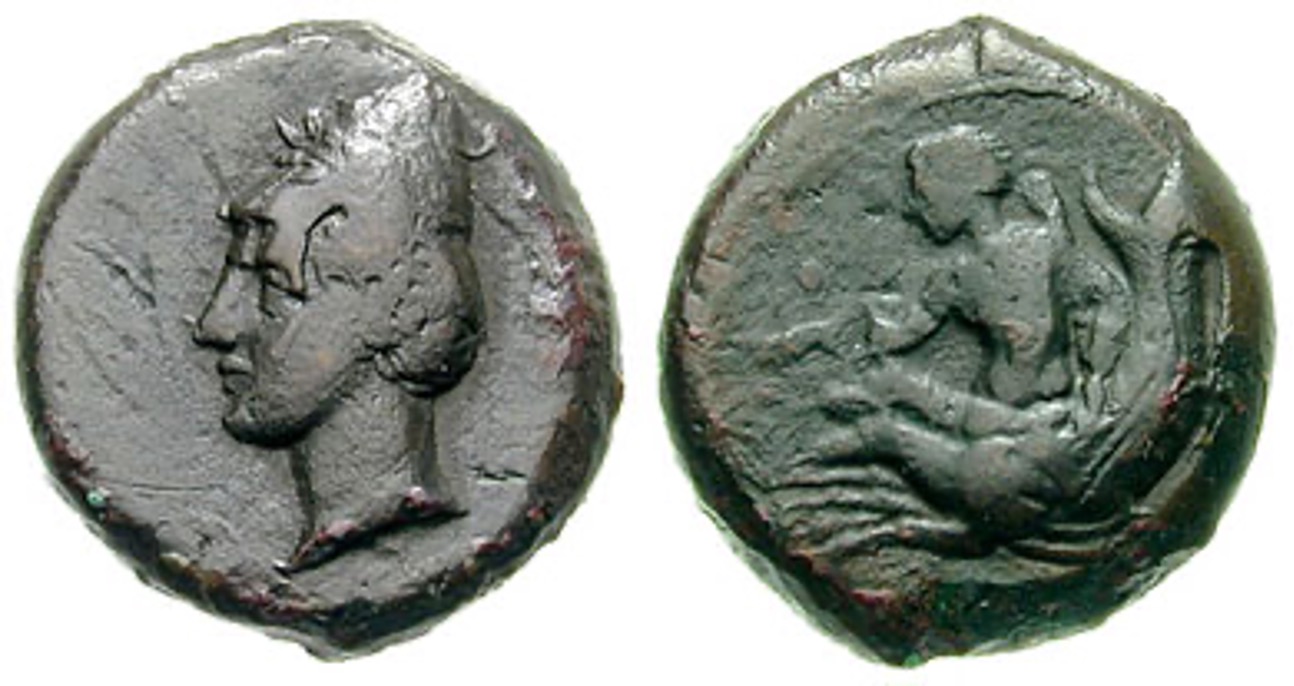1923 - Scylletium (AE head with pileus/Scylla) over Syracuse (Athena/hippocamp) (Triton, V, Jan. 2002, 193)
From SILVER
(Redirected from SO 1422 - Scylletium over Syracuse)
350 BCE - 325 BCE
Images
Overstruck variety

Athena Syracuse Hippocamp bronze .jpeg [1]
Location/history
| Sale(s)Sale(s) ᵖ: | Triton, V, 15 Jan. 2002, 193 | |
Overstriking coin
Description
| ObverseInscription or printing placed on the obverse.: | Male head left, wearing laureate pileus. | ReverseInscription or printing placed on the reverse.: | Skylla riding left on two dogs-fishs, holding club. Linear border. |
Mint and issuing power
| MintIdentifies the place of manufacture or issue of a numismatic object.: | Scylletium | Ancient regionAncient region. | Bruttium | Modern countryModern country: Italy | AuthorityIdentifies the issuing power. The authority can be "pretended" when the name or the portrait of X is on the coin but he/she was not the issuing power. It can also be "uncertain" when there is no mention of X on the coin but he/she was the issuing power according to the historical sources: |
Chronology
| FromIdentifies the initial date in a range assigned in a numismatic context. 350 BCE toIdentifies the final date in a range assigned in a numismatic context.. 325 BCE | Classical 480-323 BC |
Physical description
| MetalThe physical material (usually metal) from which an object is made.: Bronze |
WeightWeight of the numismatic object (in grams). in grams: 8.628.62 g <br />8,620 mg <br /> | ||
References
| Coin referenceReference of the Coin: | Coin series referenceReference to coin series study: | HN Italy1HN Italy, n° 2565, HGC 12HGC 1, n° 1722 | |
| Coin series web referenceCoin series web references: | |||
Overstruck type
Description
| ObverseInscription or printing placed on the obverse.: | Athena | ReverseInscription or printing placed on the reverse.: | Hippocamp (visible on obverse: tail on pileus) |
Mint and issuing power
| MintIdentifies the place of manufacture or issue of a numismatic object. ᵖ: | Syracuse | Ancient regionAncient region. ᵖ | Sicily | Modern countryModern country: Italy | AuthorityIdentifies the authority in whose name (explicitly or implicitly) a numismatic object was issued. ᵖ: |
Chronology
| FromIdentifies the initial date in a range assigned in a numismatic context. 405 BCE toIdentifies the final date in a range assigned in a numismatic context.. 367 BCE | Classical 480-323 BC |
Physical description
| DenominationTerm indicating the value of a numismatic object. Examples: tetradrachm, chalkous, denarius. ᵖ: | litra |
References
| Coin type referenceReference to coin series study ᵖ: | Calciati 19863Calciati 1986, p. 87, n° 42 |
Additional data
| Frequency of overstrikesFrequency of overstrikes: | Level of confidenceLevel of confidence of the identification: | ||
| RemarksRemarks: | "Appears to be overstruck on a Syracusan litra, Athena/Hippocamp (Calciati 1986, p. 87, n° 42), with a trace of the hippocamp's tail visible on the pileus. Often attributed to Skylletium in Bruttium on the basis of the Skylla on the reverse, this type has been found in excavations in Locri and in north-central Sicily, and as is the case with this coin, is often times overstruck on a Syracusan litra" | ||
References
- ^ Rutter N. Keith et alii (eds.) (2001), Historia Numorum Italy, London, xvi, 223 p., 43 pl.
- ^ Hoover, Oliver D. (2018), The Handbook of Greek Coinage Series, Volume 1. Handbook of Coins of Italy and Magna Graecia, Sixth to First Centuries BC., Lancaster-London, 2018, lxi, 527 pages, 23 cm
- ^ Calciati, Romolo (1986), Corpus nummorum siculorum. La monetazione di bronzo/The bronze coinage, vol. 2, Milan, Edizioni G. M.
